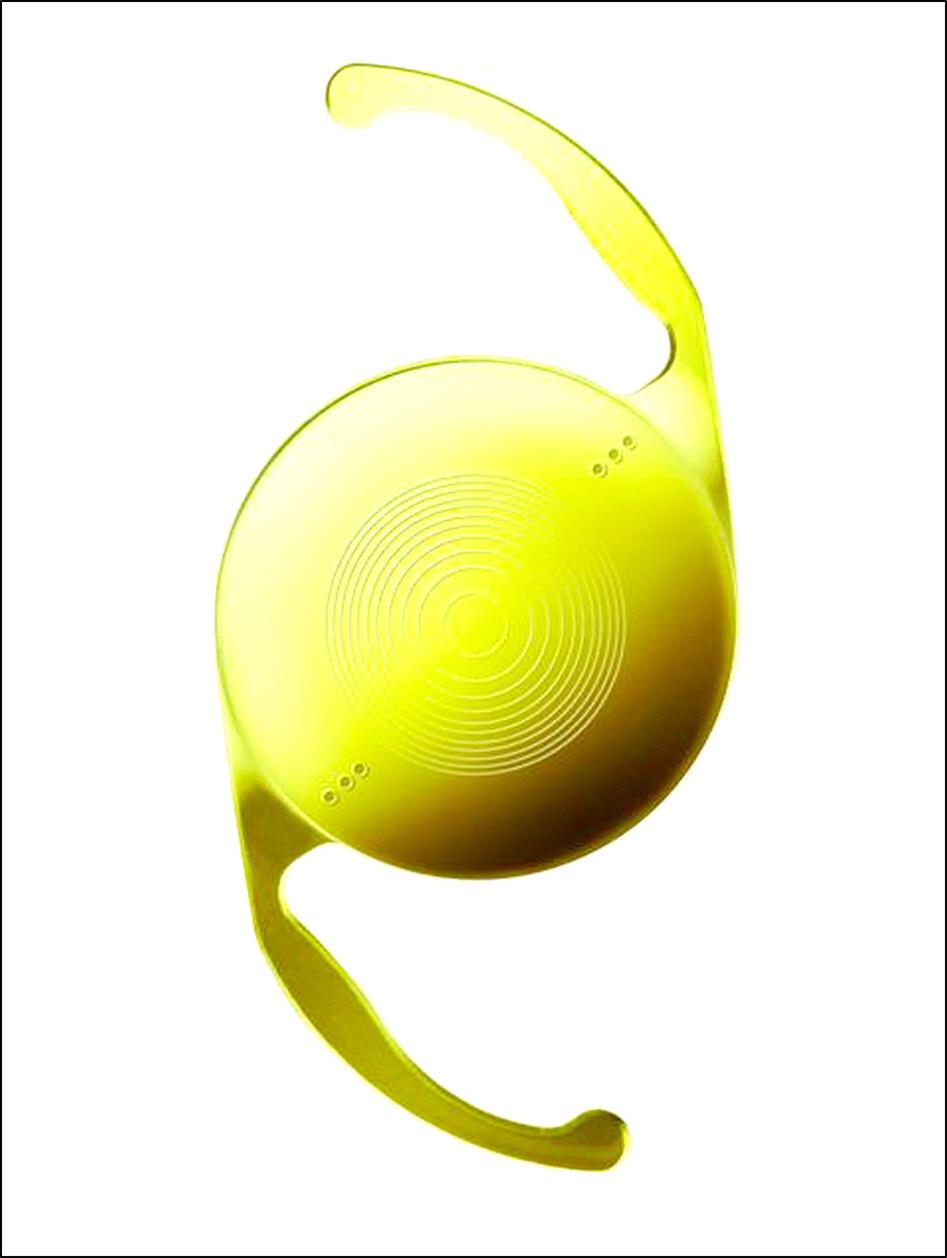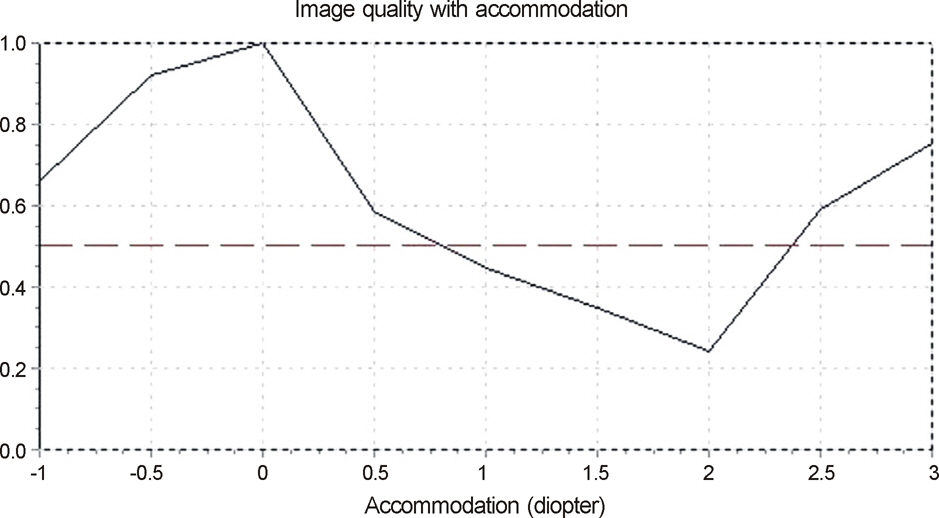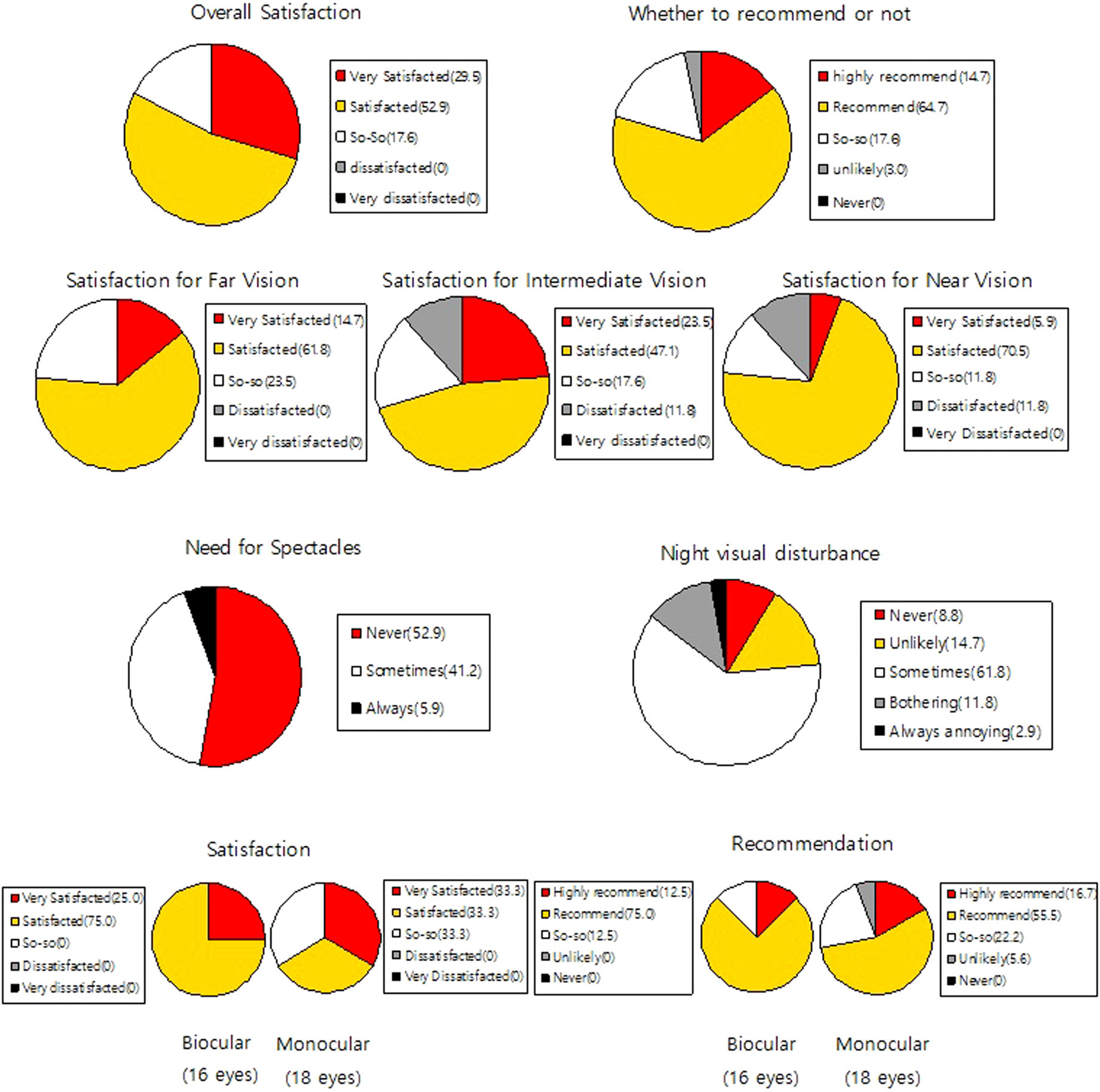J Korean Ophthalmol Soc.
2014 Aug;55(8):1139-1149.
Clinical Outcomes of Diffractive Multifocal Toric Intraocular Lens Implantation
- Affiliations
-
- 1Cheil Eye Hospital, Daegu, Korea. eyepark9@naver.com
Abstract
- PURPOSE
To evaluate the clinical outcomes of patients with diffractive multifocal toric intraocular lens (IOL) implantation.
METHODS
Thirty-four eyes of 26 patients underwent diffractive multifocal toric IOL. Uncorrected visual acuity (UCVA) at distant, intermediate and near and residual refractive astigmatism were measured on the first day, at 2 weeks, and 1, 3 and 6 months postoperatively. Optical quality obtained using the Optical Quality Analysis System II (OQAS II), high-order aberrations (HOA) and patient satisfaction questionnaire were evaluated 3 months postoperatively.
RESULTS
At the 6 month postoperative visit, the mean UCVA at distant, intermediate (63 cm, 100 cm) and near were 0.06 +/- 0.07, 0.18 +/- 0.11, 0.16 +/- 0.12 and 0.03 +/- 0.06 (log MAR), respectively. The refractive astigmatism decreased significantly from -1.66 +/- 1.04 D to -0.54 +/- 0.32 D at 6 months postoperatively (p < 0.01). The means of objective scatter index, modulation transfer function (MTF) cut-off value, Strehl ratio and pseudo-accommodation range measured by OQAS II were 1.33 +/- 0.67, 37.24 +/- 9.67 cdp, 0.22 +/- 0.09 and 3.08 +/- 0.53 D, respectively. HOA scores for 5 mm and 6 mm were 0.30 +/- 0.09 and 0.49 +/- 0.15, respectively; 82.3% of the patients were satisfied with the postoperative results, 79.4% of the patients reported they would recommend the procedure to others, and 14.7% of patients reported moderate or severe visual disturbance at night.
CONCLUSIONS
Implantation of a diffractive multifocal toric IOL in patients with cataract and corneal astigmatism provided excellent distant, intermediate, and near visual outcomes, good optical quality and high patient satisfaction.
MeSH Terms
Figure
Reference
-
References
1. Blaylock JF, Si Z, Vickers C. Visual and refractive status at different focal distances after implantation of the ReSTOR multifocal intraocular lens. J Cataract Refract Surg. 2006; 32:1464–73.
Article2. Kohnen T, Allen D, Boureau C, et al. European multicenter study of the AcrySof ReSTOR apodized diffractive intraocular lens. Ophthalmology. 2006; 113:578–84.
Article3. Alfonso JF, Fernandez-Vega L, Baamonde MB, Montes-Mico R. Prospective visual evaluation of apodized diffractive intraocular lenses. J Cataract Refract Surg. 2007; 33:1235–43.
Article4. Lee HS, Park SH, Kim MS. Clinical results and some problems of multifocal apodized diffractive intraocular lens implantation. J Korean Ophthalmol Soc. 2008; 49:1235–41.
Article5. Cheon MH, Lee JE, Kim JH, et al. One-year outcome of monocular implant of aspheric multifocal IOL. J Korean Ophthalmol Soc. 2010; 51:822–8.
Article6. Kang EC, Kim EK, Kim TI. Comparisons of visual acuity, spherical aberration and contrast sensitivity among spheric, aspheric ReSTOR(R), and Crystalens HD(R) lenses. J Korean Ophthalmol Soc. 2011; 52:1275–80.7. Kim SM, Kim CH, Chung ES, Chung TY. Visual outcome and patient satisfaction after implantation of multifocal IOLs: three- month follow-up results. J Korean Ophthalmol Soc. 2012; 53:230–7.8. Kim S, Kim MS. The study on target refraction to improve visual quality in patients implanted with multifocal IOL. J Korean Ophthalmol Soc. 2012; 53:223–9.
Article9. Gwak JY, Choi JS, Pak KH, Baek NH. Visual and optical functions after diffractive multifocal intraocular lens. J Korean Ophthalmol Soc. 2012; 53:396–402.10. Hayashi K, Manabe S, Yoshida M, Hayashi H. Effect of astigmatism on visual acuity in eyes with a diffractive multifocal intraocular lens. J Cataract Refract Surg. 2010; 36:1323–9.
Article11. Ferrer-Blasco T, Montes-Mico R, Peixoto-de-Matos SC, et al. Prevalence of corneal astigmatism before cataract surgery. J Cataract Refract Surg. 2009; 35:70–5.
Article12. Budak K, Friedman NJ, Koch DD. Limbal relaxing incisions with cataract surgery. J Cataract Refract Surg. 1998; 24:503–8.
Article13. Kaufmann C, Peter J, Ooi K, et al. Limbal relaxing incisions versus on-axis incisions to reduce corneal astigmatism at the time of cataract surgery. J Cataract Refract Surg. 2005; 31:2261–5.
Article14. Jendritza BB, Knorz MC, Morton S. Wavefront-guided excimer laser vision correction after multifocal IOL implantation. J Refract Surg. 2008; 24:274–9.
Article15. Kim SI, Kim SJ, Oh JY, et al. The effects of laser refractive surgery for correcting residual refractive error after implantation of ReSTOR(R) multifocal IOL. J Koμ Ophthalmol Soc. 2012; 53:1742–8.16. Kim MH, Chung TY, Chung ES. Long-term efficacy and rotational stability of AcrySof toric intraocular lens impalntation in cataract surgery. Korean J Ophthalmol. 2010; 24:207–12.17. Visser N, Bauer NJ, Nuijts RM. Toric intraocular lenses: Historical overview, patient selection, IOL calculation, surgical techniques, clinical outcomes, and complications. J Cataract Refract Surg. 2013; 39:624–37.
Article18. Ferreira TB, Marques EF, Rodrigues A, Montes-Mico R. Visual and optical outcomes of a diffractive multifocal toric intraocular lens. J Cataract Refract Surg. 2013; 39:1029–35.
Article19. Visser N, Nuijts RM, de Vries NE, Bauer NJ. Visual outcomes and patient satisfaction after cataract surgery with toric multifocal intraocular lens implantation. J Cataract Refract Surg. 2011; 37:2034–42.
Article20. Mojzis P, Pinero DP, Ctvrteckova V, Rydlova I. Analysis of internal astigmatism and higher order aberrations in eyes implanted with a new diffractive multifocal toric intraocular lens. Graefes Arch Clin Exp Ophthalmol. 2013; 251:341–8.
Article21. Koch DD, Ali SF, Weikert MP, et al. Contribution of posterior corneal astigmatism to total corneal astigmatism. J Cataract Refract Surg. 2012; 38:2080–7.
Article22. Ho JD, Tsai CY, Liou SW. Accuracy of corneal astigmatism estimation by neglecting the posterior corneal surface measurement. Am J Ophthalmol. 2009; 147:788–95.
Article23. Eom Y, Nam KT, Kang SY, et al. Axis Difference between corneal and internal astigmatism to consider for toric intraocular lenses. Am J Ophthalmol. 2013; 156:1112–9.e2.
Article24. Lee JM, Seo KY, Kim EK. Comparison of optical aberrations and contrast sensitivity between monofocal and multifocal intraocular lens. J Korean Ophthalmol Soc. 2002; 43:1882–6.25. Montes-Mico R, Espana E, Bueno I, et al. Visual performance with multifocal intraocular lenses mesopic contrast sensitivity under distance and near conditions. Ophthalmology. 2004; 111:85–96.26. Vingolo EM, Grenga P, Iacobelli L, Grenga R. Visual acuity and contrast sensitivity: AcrySof ReSTOR apodized diffractive versus AcrySof SA60AT monofocal intraocular lenses. J Cataract Refract Surg. 2007; 33:1244–7.
Article27. Nochez Y, Majzoub S, Pisella PJ. Effect of interaction of macroaberrations and scattered light on objective quality of vision in pseudophakic eyes with aspheric monofocal intraocular lenses. J Cataract Refract Surg. 2012; 38:633–40.
Article28. Diaz-Valle D, Arriola-Villalobos P, Garcia-Vidal SE, et al. Effect of lubricating eyedrops on ocular light scattering as a measure of vision quality in patients with dry eye. J Cataract Refract Surg. 2012; 38:1192–7.
Article29. Cabot F, Saad A, McAlinden C, et al. Objective assessment of crystalline lens opacity level by measuring ocular light scattering with a double-pass system. Am J Ophthalmol. 2013; 155:629–35.
Article30. Lee K, Ahn JM, Kim EK, Kim TI. Comparison of optical quality parameters and ocular aberrations after wavefront-guided laser in-situ keratomileusis versus wavefront-guided laser epithelial keratomileusis for myopia. Graefes Arch Clin Exp Ophthalmol. 2013; 251:2163–9.
Article31. Saad A, Saab M, Gatinel D. Repeatability of measurements with a double-pass system. J Cataract Refract Surg. 2010; 36:28–33.
Article32. Castillo-Gomez A, Carmona-Gonzalez D, Martinez-de-la-Casa JM, et al. Evaluation of image quality after implantation of 2 diffractive multifocal intraocular lens models. J Cataract Refract Surg. 2009; 35:1244–50.33. Yoon JU, Chung JL, Hong JP, et al. Comparison of wavefront analysis and visual function between monofocal and multifocal aspheric intraocular lenses. Korean J Ophthalmol. 2009; 50:195–201.
Article
- Full Text Links
- Actions
-
Cited
- CITED
-
- Close
- Share
- Similar articles
-
- Pseudoaccomodation in Pseudophakic Eyes with 3M Multifocal Intraocular Lens
- Clinical Results of 3M Multifocal Intraocular Lens
- The Efficacy of KR-1W Aberrometer in Assessing the Astigmatism after Toric Intraocular Lens Implantation
- Multifocal Intraocular Lens Implantation after Pars Plana Vitrectomy to Treat Retinal Detachment
- Scleral Fixation of a Single-Piece AcrySof Toric Intraocular Lens: A Case Report




